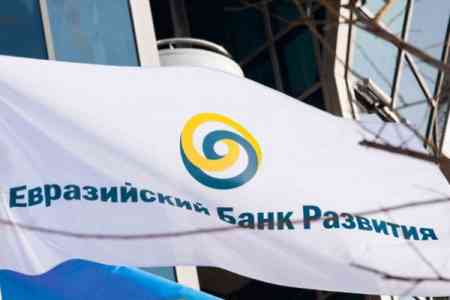


ArmInfo. According to forecasts by the Eurasian Development Bank (EDB), the Armenian economy will stabilize on a 5.5% growth trajectory with domestic demand maintaining its role as the main driver of development. This is stated in the Bank's latest Macroeconomic Review. The analytical material presents an analysis of the economic development of the Bank's member states at the beginning of 2025 and a forecast of the main macroeconomic indicators until the end of 2025 and for 2026-2027.
It is noted that inflation in Armenia is projected to be close to the target over the entire forecast horizon and will amount to 3.1% by the end of 2025 amid the recovery of world food prices and an increase in domestic demand. This will be facilitated by the recovery in world food prices, the effect of the reduction in the refinancing rate over the past year and a half, a stimulating budget policy and a moderate weakening of the dram by the end of the year. In 2026-2027. inflation will slow down somewhat after recovery in 2025 and will be close to the lower limit of the target range of the Central Bank of the Republic of Armenia, averaging 2.8% per annum. Such dynamics will be due to stabilization of growth in global food prices, the return of the economy to long-term growth rates and a slight weakening of the dram exchange rate.
With inflation in the target range of the Central Bank of the Republic of Armenia and balanced growth of domestic demand, the refinancing rate will remain at the current level (6.75%) until the end of 2025. At the same time, according to our estimates, monetary policy will have a slightly positive effect on demand this year and a neutral effect in the medium term. In 2026-2027, the rate will be close to 6.5%, which will correspond to inflation staying stable in the target range of the Central Bank of the Republic of Armenia, and GDP growth rates at a long-term sustainable level, which is estimated at about 5% per annum.
The stimulating effect of fiscal policy, high rates of household lending and recovery of remittances will support demand in 2025. In 2026 and 2027, economic growth will be close to long-term rates - 5.3% and 5.0%, respectively
The average dram exchange rate this year is expected to be at the level of the previous year - 392 drams per dollar. The exchange rate will be supported by an increase in revenues from the export of tourism services and the inflow of remittances (In January - April 2025, the net inflow of non-commercial cross-border transfers increased by 24% y/y after a decrease of 35% and 44%, respectively, in 2023 and 2024 - Bank).
The dram will be stable throughout almost the entire 2025. The recovery of the dynamics of the net inflow of remittances after a decrease in 2024 and a high level of international reserves will support the national currency. In 2026-2027, the average annual rate will be about 402 drams per dollar. The gradual moderate weakening of the Armenian dram compared to the current year will occur against the backdrop of lower rates on the money market and a slowdown in economic growth. In addition, the dynamics of the dram exchange rate will be affected by the growth of imports in the context of stable domestic consumer and investment demand.
Speaking about the stimulating budget policy of the Armenian government in 2025, the Bank's analysts note its significant impact on demand in 2025, given the plans to achieve a budget deficit of 5.5% of GDP after 3.7% in 2024. The expansion of the deficit will be associated with an increase in the level of expenditures by 1.8 percentage points to 30.8% of GDP, while revenues in 2025 will be stable - 25.3% of GDP. The government plans to increase the level of capital expenditures to 6.3% of GDP in 2025 and stabilize them at 5.9% of GDP in 2026-2027. Successful implementation of these plans will contribute to an increase in overall productivity, which will have a positive impact on the rate of potential economic growth in the medium term. In 2026-2027. EDB analysts forecast a neutral impact of budget policy on demand, taking into account a gradual reduction in expenditure to 29% of GDP and an increase in tax revenues to 25% of GDP by 2027
At the same time, the Bank's analysts consider the probability of a sharp outflow of capital and labor and associated economic losses to be an unlikely risk for the Armenian economy. The outflow process will most likely be extended over time, and its impact will be gradual, so the economy will have time to adapt to the new conditions and compensate for losses in other ways. The deterioration of the geopolitical situation in the region increases the uncertainty of forecasts regarding the main macroeconomic indicators. If unfavorable scenarios are realized, pro-inflationary risks and risks of weakening external demand will increase, and the country risk premium will increase.
In general, EDB analysts note different dynamics of growth rates of the economies of the participating countries. High growth rates are maintained by the countries of Central Asia and Armenia, with a slight slowdown in the dynamics in Russia and Belarus. According to the results of the first half of 2025, the aggregate GDP of the Bank's member countries grew by 2.1%. <At the same time, the EDB member countries continue to actively create new sources of growth. Investment growth rates in most countries (Armenia, Belarus, Kazakhstan, Kyrgyzstan and Tajikistan) remain double-digit. Investment growth is formed both by internal sources and by attracting external financing, including FDI. This indicates the high adaptability of the countries of the region to the new realities of the global economy>, - noted Evgeny Vinokurov, Chief Economist of the Eurasian Development Bank.